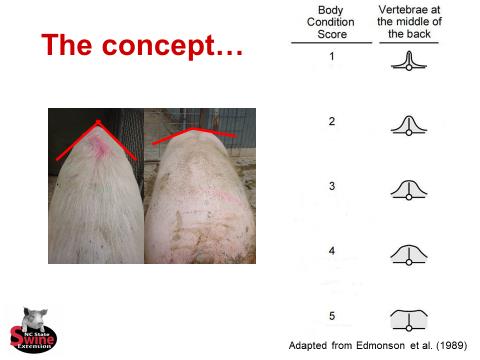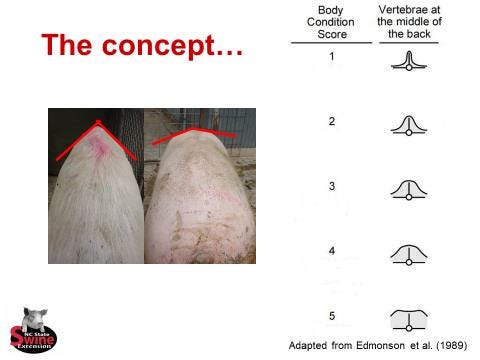October 12, 2017

By Mark Knauer, North Carolina State University & Dave Baitinger, Baitinger Engineering
The importance of properly managing sow body condition is clear. Preventing over conditioned sows reduces gestation feed costs and enhances reproductive performance while preventing thin sows improves animal well-being. Hence, objective sow body condition tools can help workers accurately care for sows, take the subjectivity out of visual scoring and increase farm profits.
The sow body condition caliper has been a story of perseverance. Six years ago we invented a prototype for a crude tool that objectively measures sow body condition. The prototype was based on the premise that as a sow gains weight, fat and muscle, the angularity of her back changes (Figure 1). At the time, no funding agencies were willing to support identifying optimal sow body condition in relation to subsequent performance. Of the five grants that we submitted, zero were funded. So we found a way to get the needed studies done anyway. Today, data from those studies are used around the world on a daily basis. In the past several years we have distributed calipers to 22 states and 21 countries around the world. We estimate 2 to 4% of the world is using the caliper despite $0 spent on advertising.
Figure 1. The concept behind the sow body condition caliper. The tool quantifies the angularity of a sow’s back. As a sow gains weight, fat and muscle, the angularity of her back changes. The sow on the left is thin, and the sow on the right is over conditioned.

Today the sow body condition caliper is a story about profitability. We have received numerous reports of the sow caliper reducing gestation feed intake and enhancing lactation feed intake. In relation to reproduction, we found an ideal sow caliper score in regard subsequent reproductive throughput in two studies (Figure 2). These studies were conducted in large, integrated production systems using genetics that are thought to be quite different. Yet, ideal body condition in relation to subsequent number weaned was similar between studies. From a labor standpoint, compared to ultrasound backfat, the sow caliper greatly reduces labor requirements (Figure 3). However, the sow caliper may not be for everyone. If you have experienced labor that excels at visual body condition evaluation, the sow caliper may not be for you. Still, if your farm is overfeeding in gestation, the return on investment of the sow caliper can be enormous.
Figure 2. Impact of sow body condition caliper score on subsequent number weaned in two large, integrated production systems.

Figure 3. Time required to assess sow body condition by technology. Sows were evaluated in gestation stalls by an experienced technician.

For more information or to purchase a sow body condition caliper please contact Mark Knauer at [email protected]. Sow calipers are $200 a piece plus shipping with no volume discounts. The sow body condition has truly been a paradigm change in sow management. Yet we hope to continue further development of technologies that can enhance animal well-being and improve farm profitability.
References:
Bryan, M. and M. Knauer. 2014 (Abstr.). Relationships between sow body condition with subsequent reproductive performance. J. Anim. Sci. 92(Suppl. 2):25.
Bryan, M. R., D. C. Kendall, D. Baitinger, and M. T. Knauer. 2013. Relationships between body condition and subsequent reproductive performance for sows housed in individual pens. J. Anim. Sci. 91(Suppl. 2):68.
Knauer, M., and M. Bryan. 2015. Labor requirements and repeatability of sow body condition measures. J. Anim. Sci. 93(Suppl. 2):112.
Knauer, M. T., and D. J. Baitinger. 2015. The sow body condition caliper. Appl. Eng. Agric. 31(2):175-178.
You May Also Like



